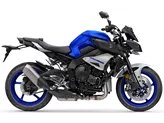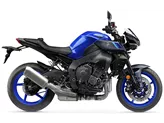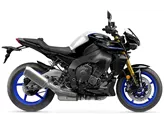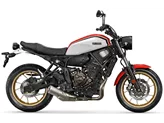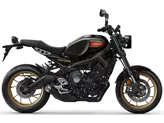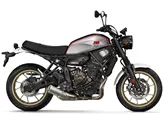Yamaha XSR900 2016 vs. Yamaha MT-10 2016

Yamaha XSR900 2016

Yamaha MT-10 2016
Overview - Yamaha XSR900 2016 vs Yamaha MT-10 2016
The Yamaha XSR900 2016 and the Yamaha MT-10 2016 are both naked bikes with similar engine types and cooling systems. However, there are several key differences between the two models.
In terms of engine power, the Yamaha MT-10 2016 has a significant advantage with 160 HP compared to the Yamaha XSR900 2016's 115 HP. This makes the MT-10 more powerful and provides a thrilling riding experience. The torque is also higher in the MT-10, with 111 Nm compared to the XSR900's 87.5 Nm. This translates to better acceleration and overall performance.
The number of cylinders also differs between the two models, with the XSR900 having 3 cylinders and the MT-10 having 4 cylinders. This again contributes to the MT-10's superior power and performance.
Both bikes have upside-down telescopic forks for the front suspension and swing arm with a monoshock for the rear suspension. This ensures a comfortable and stable ride for both models.

Yamaha XSR900 2016
In terms of chassis, the XSR900 has an aluminum frame with a twin tube design, while the MT-10 has an aluminum frame with a Deltabox design. The Deltabox frame offers better rigidity and handling, giving the MT-10 an advantage in terms of agility and high-speed stability.
Both bikes have double disk brakes at the front, but the MT-10 has larger diameter disks at 320 mm compared to the XSR900's 298 mm. This gives the MT-10 stronger and more effective braking power.
In terms of advanced rider assistance systems, both bikes have ABS as standard. However, the MT-10 also has traction control, providing an additional level of safety and control.

Yamaha MT-10 2016
When it comes to dimensions and weights, the MT-10 has a slightly shorter wheelbase at 1400 mm compared to the XSR900's 1440 mm. The seat height is also slightly higher in the MT-10 at 825 mm compared to the XSR900's 815 mm. The MT-10 is also heavier, with a kerb weight of 210 kg compared to the XSR900's 191 kg. However, the MT-10 has a larger fuel tank capacity at 17 liters compared to the XSR900's 14 liters.
In terms of strengths, the XSR900 has a greedy engine, well-tuned riding modes, ABS and TC as standard, an authentic modern design, and clean workmanship. On the other hand, the MT-10 has a CP4 engine, a strong character, extreme agility, high-speed stability, strong brakes, and an unmistakable sound.
In terms of weaknesses, the XSR900 has a hard chassis, a seat that could be more comfortable, and a speedblock design that is already present on many other models. The MT-10, on the other hand, has poor comfort, limited wind protection, and a hard fit.
Overall, the Yamaha MT-10 2016 offers more power, better handling, and additional features compared to the Yamaha XSR900 2016. However, the XSR900 has its own strengths in terms of engine performance, design, and workmanship. Ultimately, the choice between the two models will depend on the rider's preferences and priorities.
Technical Specifications Yamaha XSR900 2016 compared to Yamaha MT-10 2016
Pros and Cons in comparison
Pros and Cons in comparison
Yamaha XSR900 2016

The XSR900 combines the performance of a sporty streetfighter with the look of a pleasing, cleanly finished retro naked bike. In doing so, the Japanese make use of their own history, which can be found bundled and without gaps in the archive of the design agency that has been working for Yamaha for 60 years. It adopts the virtues of the MT-09 and has mended some of its weaknesses. It rides more harmoniously, more controlled and, if desired, more relaxed. Only the comfort, and thus the rider, suffers from the tight chassis on bad roads. You have to be a little bit sensitive when it comes to a neo-classic.
Yamaha MT-10 2016

The short and stocky MT-10 is the furthest away from the R1 superbike of the renowned power naked bikes, both in terms of looks and chassis, but the heart of the MT-10 is directly descended from the racetrack weapon and fascinates with a uniquely raw sound and power from below thanks to the typical crank pin offset, which, with a modified firing order, ensures this unique character. The resulting 160 hp therefore only seem a little weak on paper compared to the more than 200 hp of the R1, in reality the MT-10 also ignites incredible fireworks. The suspension would probably be too soft for the race track, but it is just right for a country road fight, and the brakes do the same - probably only acceptable for the track, but perfect for the country road.
Price Comparison Avarage Market Price Yamaha XSR900 vs Yamaha MT-10
There are a few key differences between a Yamaha XSR900 2016 and a Yamaha MT-10 2016. In terms of price, the actual average price of a Yamaha MT-10 2016 is about 51% higher. A Yamaha XSR900 2016 experiences a loss of 1,650 USD in one year and 1,670 USD in two years of ownership. This is offset by a loss of 800 USD and 1,840 USD for a Yamaha MT-10 2016. Compared to Yamaha MT-10 2016 there are less Yamaha XSR900 2016 bikes available on the 1000PS.de Marketplace, specifically 5 compared to 7. It takes less time to sell a Yamaha XSR900 with 77 days compared to 97 days for a Yamaha MT-10. Since model year 2016 1000PS.de editors have written 30 reviews for the Yamaha XSR900 and 32 reviews for the Yamaha MT-10 since model year 2016. The first review for the Yamaha XSR900 was published on 11/25/2015 and now has more than 17,600 views. This compares to more than 20,700 views for the first review on Yamaha MT-10 published on 11/17/2015.







